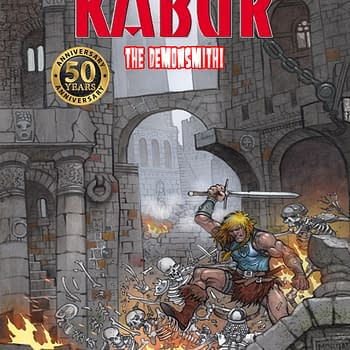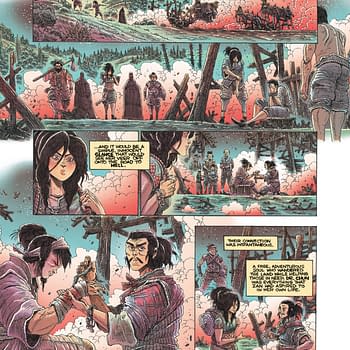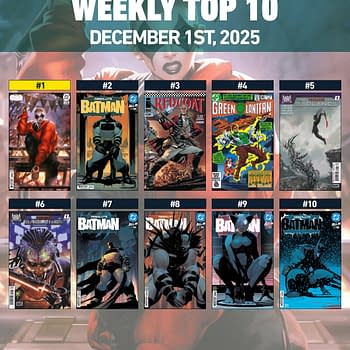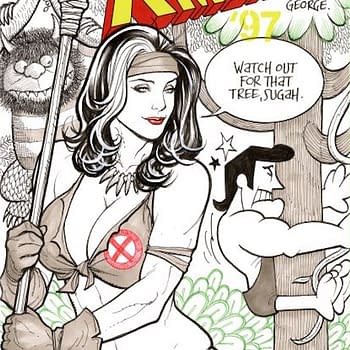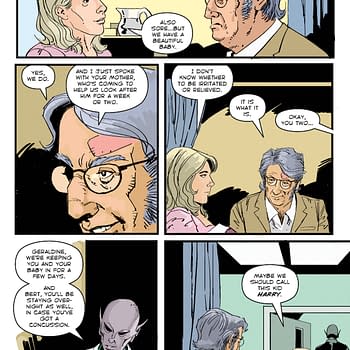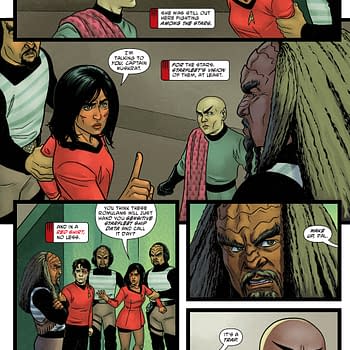Posted in: Comics | Tagged: Benjamin Percy, Comics, dynamite, entertainment, green arrow, james bond
Benjamin Percy On Tackling James Bond
Benjamin Percy is an experience writer having made his name on novels, short stories, essays, comic books and screenplays. While in the midst of his critically acclaimed run on Green Arrow, the Oregon native has taken on a new project… James Bond. I spoke to Percy about his familiarity with the iconic spy and the direction he's going in James Bond: Black Box for Dynamite Entertainment. Cover by John Cassaday, interiors by Rapha Lobosco.

BENJAMIN PERCY: I outline everything I write. Novels, screenplays, comics, even articles and short stories. I have an office closet devoted exclusively to brainstorming. The previous owner was a hobby photographer and used it as a dark room. So underneath the red light, I tack up ideas, photographs, articles, along with five- or ten-foot scrolls of paper (torn from my kids' art easel) for story maps. The room looks…a little like a serial killer's den. But the point is, I'm very interested in and analytical about story architecture. Even my biggest, knottiest, hairiest narratives (like my novel Red Moon or my work on Green Arrow) have a causal structure running through them.
I don't know every little thing about a story before writing it—that wouldn't be any fun—but I do know the brightest stars in the constellation. I guess you could say that every Bond issue has at least one of those bright stars, and in issue 1, it's that opening action set-piece in the French Alps. That sequence has been in my brain since the moment I decided to pitch the series. It's more than a showpiece of course—it's the first domino tipped that sends the rest of the design crashing forward.
DW: From a writer's perspective, what are the elements that make up a good Bond story? And how did you go about piecing them together for Black Box? Are there any elements you chose to ignore?
BP: No one wants to read a storyline that feels paint-by-numbers, but there are certain expectations that come with the franchise. Exotic locales, cool gadgets, fast cars, colorful villains, dangerous seductions? I've got you covered.
Get ready for underground casinos, sumo tournaments, a rolling weapons lab built inside of a tricked-out bus, a henchman named No Name who collects the death masks of his victims…
But what Bond readers (and viewers) are looking for is a kind of elasticity. How will I take these beloved characters and tropes and put my own unique spin on them? That's been the central concern of my work in DC's Rebirth as well. Tipping my hat to history, while moving forward with innovation.
With that in mind, Bond stories typically capture the anxieties of the time period during which they were written. Dr. No was born out of the Cuban Missile Crisis. You Only Live Twice channels Cold War paranoia.
What makes us especially fearful now? Our digital vulnerability. You see it (on a larger scale) with the Russian hacking of the US election. And you see it (on a smaller scale) in our daily lives, when a virus invades our laptop or our credit card information is stolen. So I'm taking a knife to the nerve of the moment and writing a story about cyber terror.

BP: Sean Connery. I do a pretty solid impression of him too. Corner me at a con some time and I'll spout off some lines.
He's someone everyone wants to be—or screw. He's at once suave and brutal. Pantherish in his physicality. Hyper masculine. One moment, the corner of his mouth will curl in a smile as he fires off a quip, and the next moment, a genuinely frightening anger will flash in his eyes.
I'm equally influenced by the films and novels. I grew up watching the movie marathons on TBS with my father—and then in college took a class called the Spy Novel. That was when I was introduced to Graham Greene, John le Carre and Ian Fleming—and I worked my way through the whole library of 007 novels.
DW: Your Bond seems a bit more open about what he's doing and why. A little more introspective than we normally get from him. What made you decide to go that route?
BP: One of my favorite first lines—not just the Bond novels, but from any novel—comes from Goldfinger: "James Bond, with two double bourbons inside him, sat back in the final departure lounge…and thought about life and death."
That's our introduction to the character. He's downed a considerable amount of liquor while thinking about life and death. He's a haunted man, numbing himself.
That's the thing that fascinates me about Bond. He's so damn cool…but he's also cold. He has to be, given his line of work. Fleming described him as a "blunt instrument."
Warren Ellis said it best. He talks about how all of the Bond villains are deformed on the outside, whereas Bond carries his deformities inside him. I'm acknowledging that in my work on the series.
DW: Just about every film James Bond has had a moment in the snow where they are either chasing or being chased. Timothy Dalton's being the most unique as he was riding in a cello case. What is it about Bond and skiing and what made you want to start your story that way?
BP: Dalton was a great Bond, and I wish he had stuck around longer—I love the darkness he brought to the character. That moment with the cello stands out to me. So does the gonzo ski chase at the opening of The Spy Who Loved Me—the beauty and fun and perilousness of it.
I grew up in Oregon, and spent almost every winter weekend skiing at Mt. Bachelor. And I live in Minnesota now—where we're snowbound half the year—so I'm naturally inclined to think of frosty climates as a stage for adventure.

BP: Rapha is as dorkily grateful and excited to be working on Bond as I am. He brings so much energy to the page. His layouts are wonderfully cinematic and the style feels like a slicker cousin to Eduardo Risso's work on 100 Bullets. I'm glad to have him as my partner in crime.
We email every week. My scripts tend to be dense and contain many visual references. But I tell every artist I work with the same thing: they know best. I'm sharing what's in my brain in the hopes that it will inspire them. Their vision matters more than mine.
DW: Taking a step back from the series and looking at it from the point of view of a reader. What do you think is the thing that will get fans most excited about this new James Bond adventure? What will get them to come back for more?
BP: I'm equally obsessed with the movies and books. The Bond comic series offers the best of both worlds—a visual and literary high-wire balancing act.
I listen to the theme music every morning when I get ready to work, and when I do, my eyes narrow and my heart rate jacks up and my mouth curls into a smile. I'm putting all of my heart and muscle into this series and I think my obvious love for the 007 franchise is going to be infectious, so that you'll feel the adrenaline humming in your fingertips when you turn every page.
DW: And, out of curiosity, you're now writing one of the British Writing Trifecta. Any interest in finishing it up by doing Sherlock Holmes and Doctor Who comics?
BP: That's fun to think about. I'm a Sherlock loyalist by blood. My grandfather had four bookshelves devoted to Conan Doyle—and some of these specialty volumes and critical studies I inherited from him. He kept an oversized magnifying glass on his desk. Whenever I stayed at his house, we would watch the old films and television series together. I've thought many times about pursuing a Holmes project…but who knows if they'd trust an American brute with it.
I don't have that kind of connection with Dr. Who, though I'm fond of the series because my son is always grabbing me by the wrist and saying, "Get over here. You have to watch this episode." If I ever wrote it, it would be as a love letter to him. He's more fanatic than fan. He has Tardis-themed bedsheets, T-shirt, baseball cap, snow hat, and necktie. Pop figures. The Dr. Who encyclopedia. And a plush Dalek that screeches, "Exterminate, exterminate." I probably don't have the mad hatter sensibility to do the series justice, but I'd love to write a single story, just because I know my son's head would explode.









